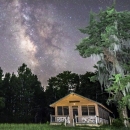About Us
Little Sandy National Wildlife Refuge was established under a conservation easement conservation easement
A conservation easement is a voluntary legal agreement between a landowner and a government agency or qualified conservation organization that restricts the type and amount of development that may take place on a property in the future. Conservation easements aim to protect habitat for birds, fish and other wildlife by limiting residential, industrial or commercial development. Contracts may prohibit alteration of the natural topography, conversion of native grassland to cropland, drainage of wetland and establishment of game farms. Easement land remains in private ownership.
Learn more about conservation easement and is closed to the public. It is part of the National Wildlife Refuge System and is managed for the benefit of wildlife and habitat. The bottomland hardwood forests of this refuge provide important habitat for resident, migrant and wintering birds. These habitats also shelter a host of other wildlife and fish species.
Unlike most National Wildlife Refuges, this refuge has no public access. Protected by a conservation easement, the land is privately owned but the habitat is protected from development by the U.S. Fish and Wildlife Service. The landowners voluntarily agreed to preserve the natural values of the property for conservation.
Our Mission
The mission of the National Wildlife Refuge System is to administer a national network of lands and waters for the conservation, management and, where appropriate, restoration of the fish, wildlife and plant resources and their habitats within the United States for the benefit of present and future generations of Americans.
Our Purpose
Every national wildlife refuge national wildlife refuge
A national wildlife refuge is typically a contiguous area of land and water managed by the U.S. Fish and Wildlife Service for the conservation and, where appropriate, restoration of fish, wildlife and plant resources and their habitats for the benefit of present and future generations of Americans.
Learn more about national wildlife refuge was created for a special purpose. Some were created to protect migratory birds, others to protect threatened or endangered species or unique habitats, while others fulfill another special purpose. Refuges are special places where wildlife comes first. All activities allowed on refuges must be evaluated to make sure each activity will not conflict with the reason the refuge was founded. Little Sandy National Wildlife Refuge was founded to protect bottomland hardwood forests that provide important habitat for resident, migrant, and wintering birds.
Our History
April 17, 1907—3,009 acres of land are purchased and incorporated as Little Sandy Hunting and Fishing Club.
December 12, 1986—A conservation easement conservation easement
A conservation easement is a voluntary legal agreement between a landowner and a government agency or qualified conservation organization that restricts the type and amount of development that may take place on a property in the future. Conservation easements aim to protect habitat for birds, fish and other wildlife by limiting residential, industrial or commercial development. Contracts may prohibit alteration of the natural topography, conversion of native grassland to cropland, drainage of wetland and establishment of game farms. Easement land remains in private ownership.
Learn more about conservation easement for Little Sandy Hunting and Fishing Club is accepted by the U.S. Fish and Wildlife Service and is renamed Little Sandy National Wildlife Refuge.
